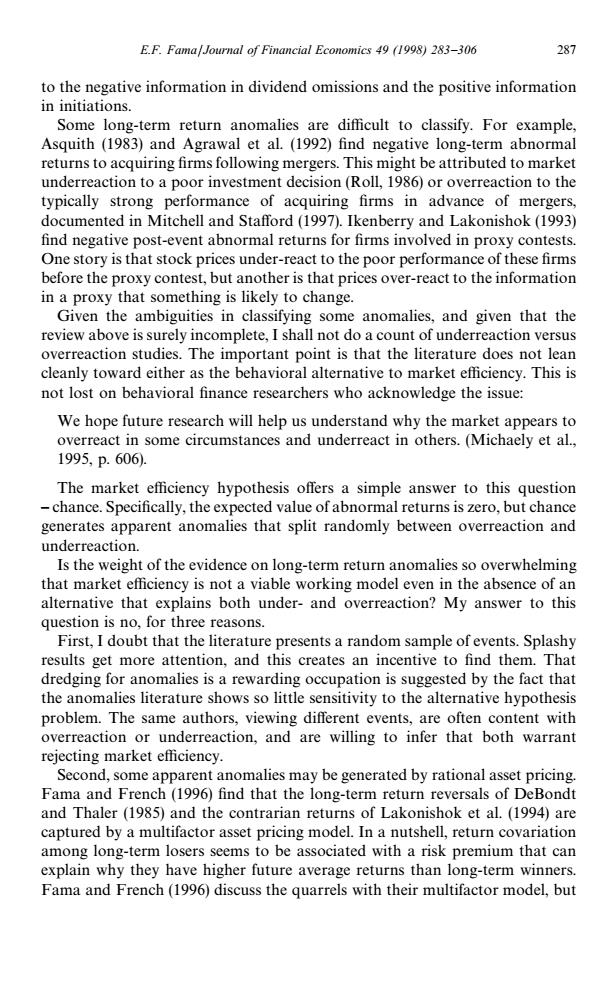正在加载图片...

E.F.FamafJournal of Financial Economics 49 (1998)283-306 287 to the negative information in dividend omissions and the positive information in initiations. Some long-term return anomalies are difficult to classify.For example, Asquith (1983)and Agrawal et al.(1992)find negative long-term abnormal returns to acquiring firms following mergers.This might be attributed to market underreaction to a poor investment decision(Roll,1986)or overreaction to the typically strong performance of acquiring firms in advance of mergers, documented in Mitchell and Stafford(1997).Ikenberry and Lakonishok(1993) find negative post-event abnormal returns for firms involved in proxy contests. One story is that stock prices under-react to the poor performance of these firms before the proxy contest,but another is that prices over-react to the information in a proxy that something is likely to change. Given the ambiguities in classifying some anomalies,and given that the review above is surely incomplete,I shall not do a count of underreaction versus overreaction studies.The important point is that the literature does not lean cleanly toward either as the behavioral alternative to market efficiency.This is not lost on behavioral finance researchers who acknowledge the issue: We hope future research will help us understand why the market appears to overreact in some circumstances and underreact in others.(Michaely et al., 1995,p.606). The market efficiency hypothesis offers a simple answer to this question -chance.Specifically,the expected value of abnormal returns is zero,but chance generates apparent anomalies that split randomly between overreaction and underreaction. Is the weight of the evidence on long-term return anomalies so overwhelming that market efficiency is not a viable working model even in the absence of an alternative that explains both under-and overreaction?My answer to this question is no,for three reasons. First,I doubt that the literature presents a random sample of events.Splashy results get more attention,and this creates an incentive to find them.That dredging for anomalies is a rewarding occupation is suggested by the fact that the anomalies literature shows so little sensitivity to the alternative hypothesis problem.The same authors,viewing different events,are often content with overreaction or underreaction,and are willing to infer that both warrant rejecting market efficiency. Second,some apparent anomalies may be generated by rational asset pricing. Fama and French(1996)find that the long-term return reversals of DeBondt and Thaler(1985)and the contrarian returns of Lakonishok et al.(1994)are captured by a multifactor asset pricing model.In a nutshell,return covariation among long-term losers seems to be associated with a risk premium that can explain why they have higher future average returns than long-term winners. Fama and French(1996)discuss the quarrels with their multifactor model,butto the negative information in dividend omissions and the positive information in initiations. Some long-term return anomalies are difficult to classify. For example, Asquith (1983) and Agrawal et al. (1992) find negative long-term abnormal returns to acquiring firms following mergers. This might be attributed to market underreaction to a poor investment decision (Roll, 1986) or overreaction to the typically strong performance of acquiring firms in advance of mergers, documented in Mitchell and Stafford (1997). Ikenberry and Lakonishok (1993) find negative post-event abnormal returns for firms involved in proxy contests. One story is that stock prices under-react to the poor performance of these firms before the proxy contest, but another is that prices over-react to the information in a proxy that something is likely to change. Given the ambiguities in classifying some anomalies, and given that the review above is surely incomplete, I shall not do a count of underreaction versus overreaction studies. The important point is that the literature does not lean cleanly toward either as the behavioral alternative to market efficiency. This is not lost on behavioral finance researchers who acknowledge the issue: We hope future research will help us understand why the market appears to overreact in some circumstances and underreact in others. (Michaely et al., 1995, p. 606). The market efficiency hypothesis offers a simple answer to this question — chance. Specifically, the expected value of abnormal returns is zero, but chance generates apparent anomalies that split randomly between overreaction and underreaction. Is the weight of the evidence on long-term return anomalies so overwhelming that market efficiency is not a viable working model even in the absence of an alternative that explains both under- and overreaction? My answer to this question is no, for three reasons. First, I doubt that the literature presents a random sample of events. Splashy results get more attention, and this creates an incentive to find them. That dredging for anomalies is a rewarding occupation is suggested by the fact that the anomalies literature shows so little sensitivity to the alternative hypothesis problem. The same authors, viewing different events, are often content with overreaction or underreaction, and are willing to infer that both warrant rejecting market efficiency. Second, some apparent anomalies may be generated by rational asset pricing. Fama and French (1996) find that the long-term return reversals of DeBondt and Thaler (1985) and the contrarian returns of Lakonishok et al. (1994) are captured by a multifactor asset pricing model. In a nutshell, return covariation among long-term losers seems to be associated with a risk premium that can explain why they have higher future average returns than long-term winners. Fama and French (1996) discuss the quarrels with their multifactor model, but E.F. Fama/Journal of Financial Economics 49 (1998) 283—306 287